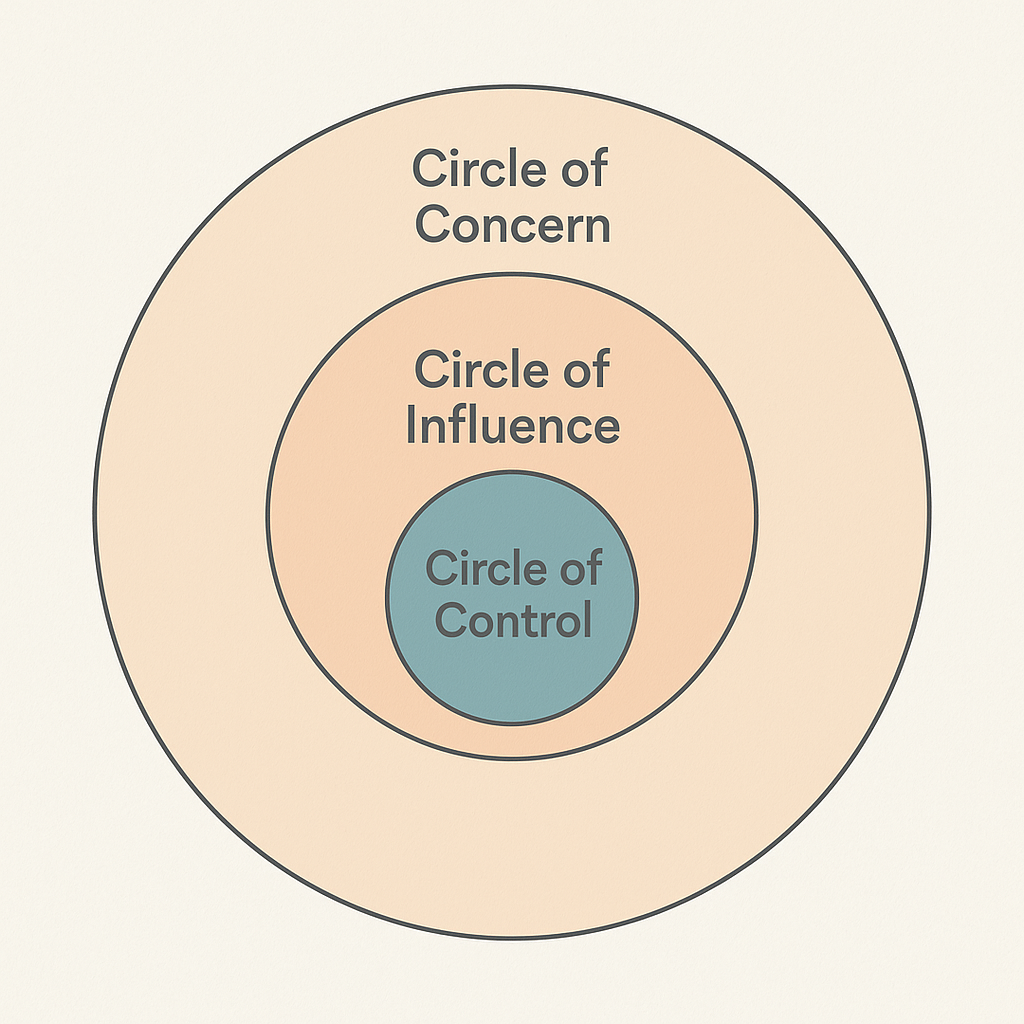One of the most useful tools I’ve picked up over the years, both in mentoring others and talking myself out of spirals at 2am, is the concept of circles of control and influence. I often bring it up in mentoring sessions, especially when someone feels stuck, overwhelmed, or convinced that everything’s falling apart and it’s somehow all their fault. (Not an uncommon sentiment, let’s be honest.)
It’s a simple idea, but a powerful one. It helps you get some distance from the chaos, zoom out a little, and ask: What can I actually do something about right now? And just as importantly: What am I burning energy on that’s actually outside my control?
The basic idea
Imagine three circles, like a target. In the middle is your Circle of Control, the stuff you have direct power over. That might include how you respond to feedback, how you manage your time, what you prioritise today, or whether you have a difficult conversation you’ve been avoiding.
Next is your Circle of Influence. These are things you don’t control directly, but you might be able to affect. Maybe you can’t force your organisation to adopt better data practices overnight (if only!), but you can make a case, start conversations, or model a more thoughtful approach in your own work. Influence isn’t immediate, and it’s rarely neat – but it’s real.
Then, beyond that, is everything else: the Circle of Concern. That includes interest rates, office politics, the fact that your Wi-Fi always cuts out right before a key Teams call, or the general trajectory of the planet. You care about these things. But you can’t meaningfully change them, at least not today, and not on your own. And if you spend all your time here, you’ll burn out or get cynical. Or both.

Where this comes in handy
I first started using this idea a year ago with a mentee who was frustrated about their team’s culture. They cared deeply about doing good work, but felt like they were constantly swimming upstream. Every idea they put forward got buried in meetings or delayed into oblivion. We mapped out what was in their control (how they prepared, the quality of what they submitted, how they responded to criticism), what they could influence (relationships with colleagues, conversations with their manager), and what was just… noise. Like how slow the organisation was to change. Or who got promoted last year. Naming those things didn’t magically fix them, but it gave my mentee back some agency.
It’s also something I use with myself, especially when I find myself tangled up in the drama of office politics or worrying about things well beyond my reach. Say there’s tension between teams, or a senior leader is making decisions that seem baffling at best, my instinct is often to fret, analyse, maybe over-function a bit (a classic move). But when I remember the circles, I stop and ask: Have I done what I can to communicate clearly? Am I showing up with integrity? Have I supported the people I’m responsible for? If the answer’s yes, then it’s time to step back. Or at least try to. (Let’s be honest, this is more art than science, and I’m very much still practising.)
Applying it to your own life
If this resonates, try it next time you’re feeling overwhelmed. Take a current challenge and map it out – literally draw the circles if that helps. Jot down what’s in your control, what you might be able to influence, and what’s just out there in the ether.
It might surprise you how much you’re worrying about things that don’t belong to you. Things that feel urgent or heavy, but that no action on your part can shift. And naming that, separating what’s yours from what isn’t, can be quietly liberating.
It doesn’t mean giving up on the big stuff. It means working out the most useful place to start. It means focusing your energy where it’s likely to have an impact, not where it’ll just get soaked up and disappear. And that’s a good habit, whether you’re mentoring someone else – or just trying to make it through your own Monday morning with your sanity intact.